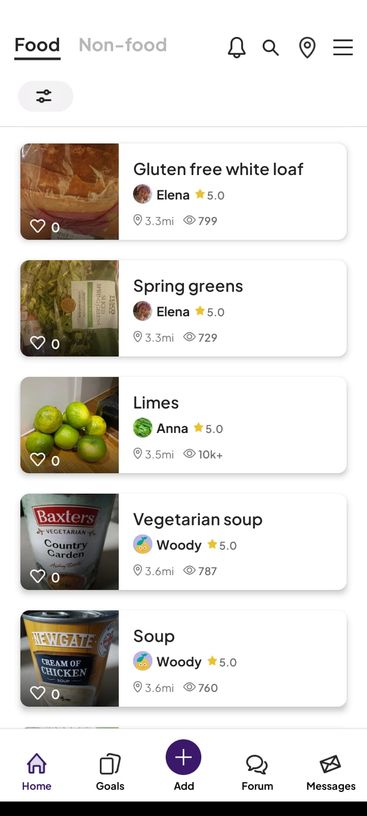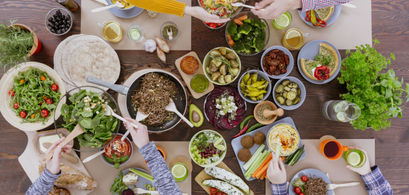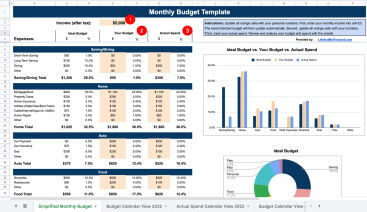If you’re anything like me, your diet probably went out of the window over the holidays, with so much tasty but unhealthy food around.
You might be looking for ways to eat more healthily. But this is easier said than done when you’re on a budget—especially when unhealthy foods are often cheaper than healthy ones.
Well, I’ve been there. But the good news is that I’ve found some budget-friendly workarounds that mean I’m not forking out for expensive health fads.
These “hacks” are all things that I regularly do myself, so I can vouch for the positive effect they’ll have on your wallet!
Get Free and Discounted Food from Apps

Who doesn’t love free food? Even better, by reducing food waste, you’re doing your bit for the environment. This is the ethos behind a variety of food redistribution apps that have sprung up in recent years.
Too Good To Go, Food For All, and Flashfood offer discounts on food from restaurants and grocery stores. Imperfect Foods and Misfits Market provide cheap groceries that would otherwise go to waste. On Olio, you can often find free food.
I’ve gotten sooo much free food from Olio (as well as free kitchen utensils and all kinds of other stuff!). Just make sure to avoid ultra-processed and other unhealthy foods. I keep an eye out for free basic ingredients—fruit, veg, meat, dairy, grains, nuts, seeds—all things I can use to cook up healthy, budget-friendly meals!
Get Free Food from the Wild

Foraging isn’t just free, it’s also a fun way to get active in nature, so it can be a great boost to your physical and mental health. There are so many interesting and tasty plants that occur naturally in the wild—crab apples, wild strawberries, elderflower, rose hips, chestnuts—the list is endless!
You might think you need to travel to the country to forage, but I live in a city and find plenty of things right on my doorstep! There’s pineapple weed for cordials, wild garlic and leek for pesto—even the humble stinging nettle can make a delicious soup.
One of my favorite things to forage is mushrooms. I found boletes (such as porcini) to be a good mushroom family to start with. They’re the tastiest (IMHO), but they’re also easy to identify for beginners and the rare toxic species are distinctive.
There are species of mushrooms and plants that are poisonous—some can even be deadly. If you’re new to foraging, get advice from experts or just stick to species that you can 100% confidently identify. The number-one foraging rule? “Don’t munch on a hunch!”
Keep Track of Your Spending
It’s difficult to stick to a budget if you don’t record your spending. I used to find that my income would quickly disappear—half the time, I wasn’t even sure where it had all gone! I don’t have that problem now that I note down all my income and expenses in a budgeting spreadsheet.
This might sound boring, but it’s easy once you get into the habit. You just need to do a quick check of your bank statement once a month or a week. And this doesn’t just apply to food—record all your expenses to see where you can save.
My budget spreadsheet showed me I was overspending on subscriptions I didn’t use. Once I’d canceled them, I actually had a bit more money to spend on healthy eating!
Improve Your Gut Health with Homemade Ferments
Recent research has shown that a healthy gut is key to achieving overall health. Having a low diversity of bacteria in your gut has been linked with a variety of conditions, such as obesity and diabetes.
If you want to keep your gut microbiome happy and diverse, an easy change you can make to your diet is eating more fermented foods. If you’re not sure what this means, an easy way to remember is the ‘four Ks’—kombucha, kefir, kimchi, and (sauer)kraut. Cheese and yogurt are fermented, too.
.jpg)
I like to save money by making my own ferments. You can ferment vegetables with just salt. For kombucha, you’ll need what’s called a SCOBY, and kefir requires kefir grains. What’s cool is that these things naturally multiply, so most people who have them are happy to give some away for free. Just look for a local ferment group or forum and ask.
To start making your own yogurt, you’ll need a few tablespoons of live yogurt. After that, you just keep a bit of your last batch of yogurt to start the next one. Buying milk (I found it works with soy milk, too, if you’re vegan!) is cheaper than buying yogurt or kefir. And to flavor my kombucha, I chuck in fruit peel and other things that would otherwise go in the bin—bargain!
You may have read that you need to buy a fancy yogurt maker, but I’ve found you can make yogurt just as easily in a thermos flask. In fact, any container will do, as long as you can keep it warm for a few hours!
Batch Cook
It’s healthiest to cook meals from scratch with fresh and nutritious ingredients. But I find I don’t have the time to cook every day. It’s also tempting to be less healthy when ultra-processed foods are cheaper and quicker to prepare.
My solution? I usually make 4-6 servings when I cook.
Then I divide the leftovers into portions and keep them in the freezer in tupperware containers. This way, I can get away with only cooking once or twice a week. On the days when I’m short on time, there’s always a portion of a delicious and healthy curry or stew I can pull out of the freezer and reheat in minutes!
Bulk Buy with Other People
Ingredients are usually cheaper when you buy them in bulk. Of course, that also means a bigger upfront cost and more food that needs using up. So why not team up with your neighbors or friends?
You’ll be able to buy in bulk from stores like Costco, Walmart, and Sam’s Club. There may be a membership fee to access some services, but this could still work out pretty cheap if you’re splitting the cost with others. With enough people, you could buy whole pallets of food on the cheap!
If you want to access warehouse prices without paying for a membership, you could try Instacart. The app lets you order from warehouse clubs like Costco and Sam’s Club without being a member.
Buy Frozen Fruit and Veg
It can be tough getting your 5 a day when fresh fruit and vegetables are often pricier than ultra-processed foods. Buying them frozen is not only cheaper but could even be healthier in some cases. Fruit and veg that will be frozen are picked when they’re most nutrient-rich, and freezing helps preserve those nutrients.

What’s more, you can keep fruits and vegetables in your freezer much longer. This helps you avoid wasting money on food that you end up chucking out because it’s going off.
Personally, I love strawberries, raspberries—all kinds of berries really. But I can’t afford to buy them fresh all the time. Having a bag of berries in the freezer means I always have something to add to my yogurt, nuts, and seeds for a super healthy smoothie or breakfast!
Cut Down on Takeout
I’m not saying you can never order takeout. Being on a budget shouldn’t mean that you never have any fun, and I really enjoy having the odd takeout meal. But if you eat takeout a lot, it can add up to a huge drain on your finances. So, maybe try limiting yourself to one or two takeout meals each month.
If you go out to work, it can be tempting to slide into the easy habit of buying coffee and lunch out. But if you buy a $4 coffee and a $10 lunch five days a week, that quickly adds up to $70 a week. Just think: if you made your own coffee and lunch, you could save $3,600 a year!
I like to prepare a healthy salad or egg casserole the night before. Or if I have a busy week ahead, I might even prep all my lunches on Sunday night.
Eat More Veggie Meals
If you’re already vegetarian or vegan, then great. But for the meat eaters among us, you’ll have noticed that meat is increasingly expensive. To avoid being hit too hard by “meatflation”, try eating an extra one or two vegetarian meals each week. This will be kinder on the planet, as well as your wallet.
It can also encourage you to eat a greater variety of plants. Studies suggest that eating at least 30 different plants per week can boost your all-important gut health, and even reduce the risk of conditions like heart disease, diabetes, and cancer.
Plants doesn’t just mean fruit and veg—think nuts, seeds, herbs, spices, grains. Thirty might sound like a daunting number, but it’s not actually that hard with a little creativity. In fact, with berries, nuts, and seeds for breakfast; a salad for lunch; and a veggie curry for dinner; I often top 30 in a single day!
Stick to an Eating Window
This one might not be immediately obvious, but recent research has suggested that keeping all your eating within a 10-hour window can improve your mood and lead to better sleep and lower hunger levels.
I actually feel more satiated when sticking to an eating window. And it’s a boon for my budget, too, as I’m spending less money on snacking!
— — —
Don’t feel pressured to do everything on this list. This is just what worked for me. But even if you just pick a few of these hacks, your body and your wallet will thank you.
The most important thing for sticking to a diet or a budget is consistency. So just try whichever hacks you think you could stick to. You can even try and come up with some budget-friendly health hacks of your own!



.jpg)



